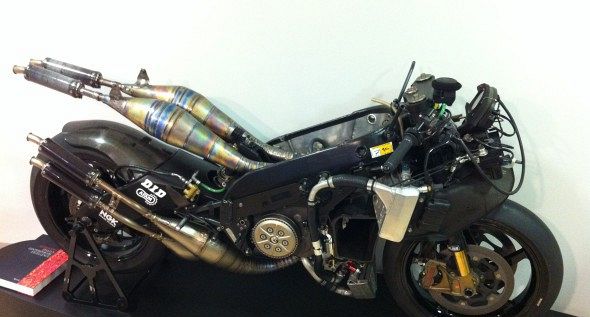I haven’t made an exhaust pipe in years. The process began with the application—for example, a rider wanting a set of cross-over pipes for a TZ350 Yamaha two-stroke road racer. Before the coming of high-arched “banana” swingarms, the big problem was how to fit the fat part of a two-stroke pipe on the chain side of the bike. By making the front part of the two pipes look like a person’s crossed arms, extra length was used up ahead of the engine, thereby pulling the fat part of the left pipe far enough forward to be out of conflict with the drive chain.
Next, I’d see if the necessary dimensions were in my pipe archive. Then I could phone Aircone, Inc, of Henderson, Nevada (their magnet-backed business card is still stuck to my fridge) and order a set of cones to my dimensions, in 20-gauge steel, rolled and butted.
The bike, or one like it, had to physically be in the shop—you can’t make closely-fitted pipes without the bike. One of my three-cylinder customers had bought and crashed on three sets of made-on-a-jig drag-o-pipes that had acted as sidestands in corners. Building pipes on the bike allows you to make the dimples and other accommodations that bring the pipes up and in as far as they can be.
Next came machining steel couplers to fit onto the engine’s exhaust outlets—a lathe project. And when the cone set arrives, the tedious hours of welding, cutting, rotating, fitting, body-working the welds smooth over mandrels, and repeating, could begin. No talking, no phone calls.
Making pipes was a sentence, time that you knew you had to do. End-to-end, a pipe might have 32 butt welds. I couldn’t use tubing bends to make the curved headers because modern two-strokes all had tapered headers. That meant making the curves ¾ of an inch at a step, and body-working each step to make a smooth whole.
What really killed it for me were the beautiful section-welded titanium pipes that began to appear on the 500cc two-stroke GP bikes (photo above). So beautiful. So unapproachably beautiful. I loved the way the segments blended into each other to make a perfect shape. When I’d finish a set of my own steel pipes, I would stand and look, because they were nice to look at. But once the factories adopted titanium, my pipes looked crude, and, anyway, two-strokes in the US were mostly in vintage racing by the 1990s.
The gas bottles are in the shop and my Smiths “Airline” torch with its range of sizes of copper tips is waiting, along with all my Mikuni jets and Robinson safety-wire twister, in case time reversal suddenly occurs.











24
Comment